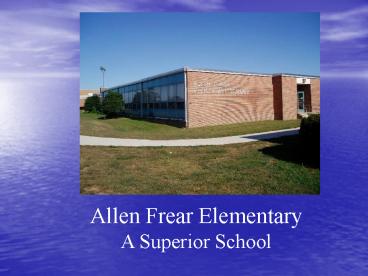Allen Frear Elementary A Superior School PowerPoint PPT Presentation
1 / 20
Title: Allen Frear Elementary A Superior School
1
Allen Frear ElementaryA Superior School
2
DSTP Reading
3
DSTP Math
4
Collaborative Learning Communities at Allen Frear
- At each grade level, teachers work together to
map out essential learning targets in one subject
area, either math or language arts. - Every seven days, teachers meet in grade level
teams to discuss data concerning student
performance based on essential learning targets. - The teams use the data gathered in order to guide
and differentiate their lessons as necessary in
order to meet individual student needs.
5
Collaborative Learning Communities Focus on
Results in Two Ways
- To identify students who need more time and
support for learning, as well as those students
who are ready for enrichment. - To identify strategies to improve upon both our
individual and collective ability to teach each
essential skill and concept.
6
Essential Questions
- Decisions are based on What is in the best
interest of our students? - Essential Outcomes What do we want our students
to be able to do? - How will we know when they know? How will we
know if students have met the targets for the
Essential Outcomes? - How will we, as a school, respond to students who
dont learn? - How will we respond when students do learn?
7
The of a Collaborative
Learning Communities
Big Ideas
- Collaborative Learning Communities help to
promote gains in student achievement, higher
quality solutions to problems and increased
confidence among staff. - Teachers are able to support one another's
strengths and weaknesses, test new ideas, support
new teachers and expand their pool of ideas,
materials, and methods. - We assess our effectiveness on the basis of
results rather than intentions. Individuals and
teams seek relevant data and information and use
that information to promote continuous
improvement.
8
An Example From the Second Grade Team
9
Developing a Collaborative Learning Culture
- Created 2nd grade Essential Outcomes for ELA in
reading for the first marking period. - Students will be able to communicate in writing
by restating and answering the question. (This
refers to the R and A of RARE responses. This is
measured by a 2 or 4-point rubric.) Color coded
acronyms will be utilized. - Students will be able to communicate the reasons,
examples, and evidence of a question. (This
refers to the second R and E of RARE. This is
measured by a 2 or 4-point rubric.) Color coded
acronyms will be utilized.
10
Second Grade TeamSMART Goal for Component 5 of
DPAS II- Goal Setting
- SMART Goal
- 85 of the students in ELA will be able to
respond using RARE responses to application and
analysis (Blooms Taxonomy) comprehension
questions with scoring a 3 or higher on a 4-point
rubric by the end of the 2008-2009 school year.
11
Pre-Assessment
- The Mixed Up Chameleon!
- Please answer the following question in RARE
response. ? - 1. What happened after the chameleon spotted the
zoo? - 2. Why did the author title his book The Mixed
Up Chameleon? - 3. Why do you think this story is in a theme
called Being Me? - 4. The chameleon changes many times, but he is
still not happy. Why? Tell me how you know. - 5. What does it mean to be yourself?
- 6. Have you felt the way the mixed-up chameleon
feels? Why? - 7. The chameleon changes many times, but he is
still not happy. Why?
12
RARE Response Rubric
13
Baseline Data and Monitor of Student Progress
Activities Used to Help Achieve Goal
14
Data Analysis
- 1. In what ways are Henry and Mudge different?
In what ways are they the same? - 2. Think about the setting of Henry and Mudge
Under the Yellow Moon. How is it different from
the setting of the Mixed Up Chameleon?
15
Data Analysis
- What examples can you find in the story that show
what good friends Frog and Toad really are? - 2. What was the problem between Frog and Toad?
16
Data Analysis
1. Think about Wilson and the times you like to
be alone. What are some good and bad things
about being alone? 2. In the story, Wilson Sat
Alone Sara roared at Wilson to be his friend. If
you were in Wilsons class, what would you do to
help him not be so shy?
17
Used Data Analysis to Differentiate Instruction
- Collaborative Differentiated Instruction Planning
Process - Identified Objective of Lesson
- Listed researched-based strategies that met
students needs to help them successfully
reach/meet objective. - Determined which strategies were the best.
- Wrote a differentiated lesson
An Example of a Differentiated Lesson Students
Scoring a 4 Challenged students by extending
their thinking with higher level questions and
teaching them to make connections to other text
in the reasons and examples portion of the RARE
responses. Students Scoring a 3 Reinforced
reasons and examples by highlighting the text and
finding examples to support answers using the
text. Students Scoring a 2 Modeled and
practiced writing RARE responses. Highlighted
the text to find answers and coded the parts of
RARE. Students Scoring a 1 or 0 Modeled writing
RARE responses, provided guided practice, and
provided independent practice with RARE
responses. Highlighted the text and coded the
four parts of RARE. (Focused primarily on the
restating and answering portions.)
18
Data Analysis
- How can you tell that Mr. Putter and Tabby are
good friends? - 2. In the story, Mr. Putter was frustrated when
he tried to make his plane fly. Think of a time
when you felt frustrated. What did you do to
solve the problem?
19
Student Work Samples
20
Student Work Samples

